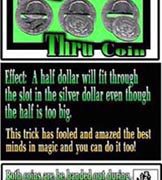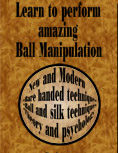When Jim Swoger, founder of The House Of Enchantment, was released from military service in 1945 he made friends with a man who worked for Rohm Haas, the Plexiglas people. Rohm Hass invented and manufactured plastic materials of different compositions and colors. Jim took a personal tour. It was a pretty big deal because he didn’t drive and they sent a chauffeured car from New Jersey to Pittsburgh and took him back. Jim brought samples home (which I still have a few of) and made the first plastic trick, a flip over box (in the photo). The next project was a
crystal box that made spring flowers appear, then he was off and running. Jim, being the first manufacturer of plastic magic, was called ” The Plastic King”. The banner to the right was made in 1948. Notice the phrase “Home Of Plastic Magic”.
Three sided Production Dice were made in 1947-48. The original dice had black spots. They were made by drilling holes completely through the white plastic. Then using a Plug Drill, dots were made from black plastic and bonding into the dice. Sparkly dots came later, which were punched out and glued to the surface.
Other items: The Massey Card Dagger was made from wood and metal andthe blade was plastic. According to Jim, Ed Massey didn’t want to spend anextra 50 cents to make the blade from metal.
Swoger experimented with different techniques in manufacturing. Genii Tubes were made, in two sizes using his oven at home. Jim laid the black and the white acrylic over two different size forms and the heat of his home oven allowed the plastic to form the shapes shown in that photo. They were then assembled into the Genii Tubes. ABC Block Tricks (without the letters) were made around 1947-48.
The Vampire Block was made until the 70s. Jim glued black plastic to red before cutting the parts for assembly. (Notice how the inside of the tube is black.)
Made in the late 40s, The Card Between Plates (T.V. card frame) is perhaps the nicest example of Jim’s work. Here you can see the emergence of the “Layered Look” the House of Enchantment is known for. The advantages to this type of construction is that the audience can see props from a distance better and the layers give these props a distinguished appearance. Below is an example of wood and plastic aterials used to make our Rib Blocks. As you can see, The house Of Enchantment is a pioneer in designing and making magic.



